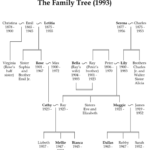Family name changes can be challenging to trace, especially when you’re trying to build your family tree. Understanding tips for deciphering family name changes will help you solve these mysteries and uncover your family’s history. Family names often change due to various reasons, such as immigration, marriage, or cultural shifts. In this article, we’ll guide you through the best ways to figure out why your family name changed and how to trace these changes across generations.
1. Understand the Common Reasons Behind Name Changes
The first of the tips for deciphering family name changes is knowing why these changes happen. Family names can change for several reasons, such as:
- Immigration: When families moved to new countries, they sometimes altered their names to make them easier to pronounce or to fit into the culture of their new home.
- Spelling variations: Over time, names were often spelled differently on official documents, such as census records, because of illiteracy or language differences.
- Marriage: Some women adopted their husband’s surname after marriage, which could change the family name.
- Simplification: Immigrants, especially in the 19th and 20th centuries, often shortened their names to make them easier to pronounce.
By understanding these common reasons, you’ll be better prepared to look for clues when researching your family name changes.

2. Check Historical Records
One of the best tips for deciphering family name changes is to explore historical records. These records can provide you with insights into how family names evolved. Look for official documents such as:
- Census records: These documents often list family members and can show variations in spelling or changes in family names.
- Birth and death certificates: These records are useful for tracking down name changes within a generation.
- Immigration records: Immigration documents often show when family names were altered, especially if the family moved to a new country.
By cross-referencing these records, you may discover why and when your family name changed.
3. Research Different Spelling Variations
Another helpful tip for deciphering family name changes is to look for spelling variations. Many family names were spelled in different ways over time. For example, surnames like “Smith” could have appeared as “Smyth,” “Smithe,” or even “Schmidt.” These variations often occurred because of phonetic spelling or language differences.
When conducting your research, be sure to look for all possible variations of your family name. Use wildcard characters in genealogy websites to search for alternative spellings and combinations. This will help you find more records and trace the family name changes across generations.
4. Talk to Older Relatives
One of the most valuable tips for deciphering family name changes is to talk to older family members. Many older relatives have stories or memories that can explain the changes in family names. They may also have documents or heirlooms that help clarify how your surname evolved.
Older family members can also provide context. For example, they may explain how the family name changed due to a marriage, an adoption, or even personal choice. So, don’t hesitate to ask them about any changes they remember in the family name.
5. Look into Local and Cultural Customs
Sometimes, family name changes are tied to local or cultural customs. In some cultures, surnames were modified based on certain traditions or events. For example, some people changed their names to reflect their religion, ethnicity, or social status. Investigate the local customs of your family’s place of origin to see if there were common practices that led to name changes.
In some cases, names were also changed to avoid discrimination or to assimilate into a new culture. For instance, immigrant families in the United States often Americanized their names to fit into mainstream society. Understanding these practices will help you decode the reasons behind a family name change.
6. Use Online Genealogy Tools
Online genealogy platforms are essential tools for deciphering family name changes. Websites like Ancestry.com, FamilySearch, and MyHeritage allow you to search for family name variations across different records. These tools can help you track down the evolution of your surname, find new branches of your family, and connect with distant relatives who may have more information.
Many of these platforms also have databases for immigration records, military records, and even newspapers, which can give you valuable clues about when and why the family name changed.
7. Be Patient and Persistent
Finally, when it comes to deciphering family name changes, patience is key. Tracing family history can be a slow and sometimes frustrating process. However, persistence pays off. Keep researching different records, reaching out to relatives, and looking for new clues.
As you go deeper into your family tree, you may uncover more variations in your surname or discover new records that explain the changes. Keep an open mind, as family history research often leads to surprising revelations.
Conclusion
In conclusion, understanding tips for deciphering family name changes is essential for uncovering your family’s history. By knowing the common reasons behind name changes, checking historical records, researching spelling variations, talking to relatives, and using online genealogy tools, you’ll be better equipped to trace your family’s surname through the generations. Remember to be patient and persistent, and enjoy the journey as you uncover the fascinating story behind your family name!











